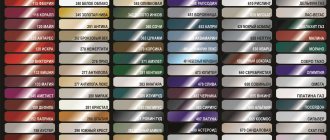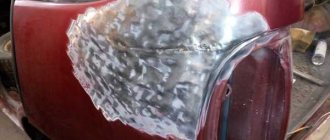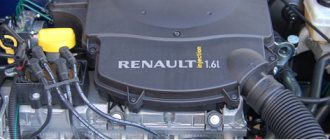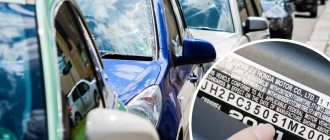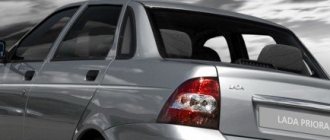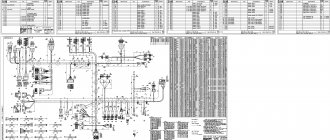Based on international standards, each car is assigned a special VIN identification code. This abbreviation stands for Vehicle Identification Number (translated from English as vehicle identification number). The set of letters and numbers for the machine is unique. Based on these data, a number of characteristics of the vehicle are determined, including the year of production. The identification code is indicated on the car itself and is duplicated in documents (registration certificate, technical passport). Each code character is an indicator of specific information.
What the code looks like
The accessory number looks different depending on the specific car manufacturer.
For example, the famous German concern Mercedes-Benz writes a code starting with the letters OM and the following three numbers. Volkswagen does the same, but instead of the letters OM it indicates EA. The engine number can be other alphanumeric or simply digital indices. First, the year of manufacture is indicated, then the modification of the engine and at the end - data on climate adaptation.
Aggregate identifier VAZ 2112
Information about the engine is placed in the VIN - this is the serial code of the vehicle, which carries information about all components. Vin requires detailed decoding.
VIN code is a reliable guide in the used car market.
What is VIN?
VIN – Vehicle Identification Number is a unique serial number used in the auto industry to identify vehicles. The number makes it possible to obtain information about the manufacturer, characteristics of the vehicle, year and country of its manufacture.
What does it consist of?
Before 1981, the problem with the use of identification codes was the lack of standardization, and different manufacturers used different code formats. However, since 1981, the VIN consists of 17 alphanumeric characters. The code does not use the letters I (i), O (o) and Q (q) due to their similarity to the numbers 0 and 1.
Modern VINs are based on two international standards, ISO 3779 and ISO 3780. They are comparable, but differ slightly in their usage. Such VIN standards are adopted in the European Union and the USA.
The structure of a car's VIN consists of three parts: WMI (World Manufacturers Identification) - world manufacturer index (1-3 characters of the number). WMI is a code assigned to a manufacturer for the purpose of identifying it. The code consists of three characters: the first indicates a geographic area, the second indicates a country in that area, and the third indicates a specific manufacturer.
VDS (Vehicle Description Section) - descriptive part (4-9 characters of the number). VDS consists of six characters that describe the properties of the vehicle. The signs themselves, the sequence of their arrangement and their meaning are determined by the manufacturer. The manufacturer has the right to fill in unused positions with signs chosen at its own discretion.
VIS (Vehicle Identification Section) - distinctive part (10-17 characters of the number). VIS is the eight-character third section of the VIN code, and the last four characters of this section must be numbers. If a manufacturer wishes to include a model year or assembly plant designator in the VIS, it is recommended that the model year designator be placed in the first position and the assembly plant designator in the second position.
Where is the body number
In most cases, the VIN code is located under the car body. But on older models, the numerical value was set on other parts. For this reason, the location of the body VIN number depends on the vehicle's production date.
The VIN code is made in the form of a nameplate. It is located:
- under the hood of a car;
- next to the driver's seat on the floor;
- on the dashboard next to the driver;
- on the threshold for the door;
- under the floor mat or trim;
- from the inside of the right wheel arch.
Manufacturers create a special window on the windshield in which the VIN code is located. Traditionally, it was installed on the cylinder block, the cylinder head, and the partition between the engine and the passenger compartment. If the vehicle is built on a frame structure, the VIN is located on the side members. Sometimes the VIN number can be found on the engine compartment. Rivets and screws are used to secure the sign.
American cars
On American models, the body number is located in different places than on domestic and European models. For a US-made car, it is located on the dashboard next to the driver.
To find the VIN code on an American car, you need to inspect the area connecting the hood and windshield. The numerical value also provides differences. The ninth position in the code is control. To determine the number corresponding to a specific letter, a special algorithm is used. This method does not work on models manufactured in other countries.
German cars
The body number on German vehicles is located in the same place as the VIN codes on cars produced in other countries. But there is a difference in the numerical value itself. The markings of cars made in Germany begin with the letter W.
Large concerns reserve several identifiers. When producing Volkswagen vehicles, the WUW identifier is used. On SUVs and crossovers, the VIN code uses the letter value WVG. A passenger car is designated by the combination WVW. For minibuses and light trucks the identifier WV2 is used.
Asian cars
The VIN code on Asian cars is installed in standard places. Asia is assigned the letters J to R. J is used by Japanese manufacturers, and K is used by South Korean manufacturers.
But not all cars made in Japan have a VIN code. This value applies to models produced by Japanese companies in other countries or in Japan, but originally planned for export. Japanese cars intended for the domestic market do not have a VIN code. Instead, they use the body number as an identifying value. But it provides limited information.
Other application sites
To increase security, body numbers are sometimes duplicated. This method reduces the likelihood of theft. Duplicate codes are made in the form of a sticker, glued anywhere on the car body. Most often, hard-to-reach places are used for this purpose.
The VIN code can be placed on any part of the car, provided that it is one-piece. It is periodically placed on the chassis. On modern vehicles, the number can be found on the upper left side of the instrument panel.
Sometimes a marking plate with the body number is installed in a visible place on the engine. If your car has Chinese side frames, you can look for the identification code there.
Instructions for verification
When inspecting a car, a potential buyer can ask for documents for the vehicle and see the VIN code. If this is not possible, then look for a sign under the hood, bumper, or on the transverse frame. VIN consists of an alphanumeric sequence (letters are Latin, numbers are Arabic). The symbols I, O, Q, U, Z are not used in creating the code, since their spelling is similar to numbers. To determine the year in which the vehicle left the assembly line, you need to:
- Find the identification code (in documents, on a plate).
- Determine which character is in 10th place in the code. This sign is an indicator of the year of manufacture.
- Check the found sign against a specific year.
Cars produced in 2001-2009 have a corresponding digital designation. For example, a car manufactured in 2001 has the number 1 in the tenth position of the code; for a 2002 car - number 2, etc. From 1980 to 2000, markings were based on the Latin alphabet, excluding symbols similar to numbers. For example, if a car was produced in 1980, then the letter A is in the tenth place of the VIN code; for vehicles manufactured in 1981 - the letter B, etc. Starting from 2010, the alphabetical marking began to repeat itself, so the letter A will also be on a car produced in 2010. It is difficult to determine the release date more accurately; there is no clear indication of the month in the code. It is customary to start the automobile year in July, so the calendar indicators do not fully correspond to the automobile ones. The year of manufacture is also indicated on the windshield if it has not been changed. Mercedes manufacturers duplicate the year of manufacture on the steering block - under the rubber pad that covers the signal button. For many foreign-made cars, the production date is written on the seat belt fasteners.
From the editor: How to choose a car for a girl
Why define this data?
When purchasing a new car at a dealership, it is worth remembering that the year of purchase is not the year of manufacture of the vehicle, but the values differ minimally. Purchasing a used car is a riskier thing; the owner will not always provide reliable information about the age of the car. If a potential buyer is able to determine the exact year of production, and it differs from the declared one, then there will be a good reason for bargaining. The year of manufacture is important when crossing the Russian border, since the amount of customs duty depends on this indicator. For cars under 3 years old it is significantly less than for older vehicles.
When insuring (both compulsory and additional) a car, much attention is paid to age; the amount of regular insurance payments depends on it. It is important to know exactly the year of manufacture of the car and when passing the technical inspection. The law stipulates that cars under 3 years old are exempt from mandatory technical inspection (the year of manufacture is taken into account, not the year of purchase). The insurance company does not require a diagnostic inspection card if the car left the assembly line less than three years ago. To accurately determine the year of vehicle production, the VIN code is used.
Country of manufacture by vehicle VIN code
Many global automakers locate their production facilities in different countries - for example, Toyota factories are located in Japan, the USA, Thailand, Canada, Indonesia and Russia. The quality of assembly often depends on the company - so the question of where a car is manufactured is quite relevant for car owners.
At the same time, car sellers do not always provide such information; it is even more difficult to obtain it when buying a car second-hand. You can find out where the vehicle was released if you have a customs declaration - although this document does not always indicate such information. The easiest way to determine the country of manufacture is by the VIN code of the car.
Using VIN to determine country
VINs are unique to each individual vehicle, much like people's fingerprints. Unlike all other vehicle documents, the code is issued once and does not change during the entire operational period.
Using the VIN, the car owner can determine the compatibility of spare parts, and the police and traffic police can identify stolen cars.
Drivers who have not previously encountered a VIN code should know that it is applied to the front left pillar of the body and the dashboard - so that it can be seen through the front window. Other places where the ID may be located include the driver's door, the inside of the hood, the insulating bulkhead, the steering column, the radiator bracket and the left fender well. Sometimes the location of the identifier is indicated in the vehicle title. Once the number is detected, you can use it to try to determine the country in which the car was manufactured.
Search stages
When starting to determine the country by the VIN code of a car, you should pay attention to the first character in a combination of 17 digits. With its help, the continent where the vehicle was produced is determined:
- the letters A to H represent Africa;
- from J to R (except for the letter O, which cannot begin with the VIN) – Asia, including the Middle East;
- from S to Z – Europe. Ford, Hyundai and Kia cars assembled in the Russian Federation are designated by the first letter X;
- numbers from 1 to 5 – North America;
- 6 and 7 – the Australian continent or New Zealand belonging to the same region;
- 8 and 9 – South America.
The second number or letter allows you to specify a specific country. For example, the combinations AA–AH indicate that the car was produced in South Africa. This could be a Volkswagen manufactured in South Africa or a car of another brand whose factories are located here.
- The character set from LA to L0 speaks of China,
- 1A-10, 4A-40 and 5A-50 - about production facilities in the USA.
The third number indicates the specific model. For example, 1 is for a Chevrolet, B and U are for a BMW, O is for an Opel, and V is for a Volvo. Considering that it is not easy to remember all these combinations, you can obtain data on the intended place of release from the corresponding tables or using special Internet resources.
Possible problems with definition
There are many sites for obtaining data by VIN code, and the probability of determining the country is quite high - but sometimes problems arise with decoding. The codes may be non-standard on cars that were manufactured before the 1980s. You can use them to obtain information about a vehicle by using paid services such as VinAudit or CARFAX.
Another problem that a potential car buyer may have is a VIN that does not match the vehicle. This can be detected by a plate with a code, noticeably different from neighboring areas. This VIN is unlikely to help obtain information about the car - however, you should not purchase a car with such a problem.
Find out when a machine leaves the assembly line by the stamp of its components
You can quickly find out the production period of a car using the markings of components. However, this is a bad way to check if you need to buy a car second-hand: all removable parts, including the windshield, can be replaced with new ones.
Windshield
Windshield manufacturers always mark the part in accordance with international standards. When branding glass, any form of numbering can be used, but the principle always remains: the year is marked with a number from 0 to 9 and the month with a letter or the exact number of dots or asterisks. In a sign combination, the symbols are used in any sequence (depending on the manufacturer’s certificate).
Determining the year of manufacture of a windshield is simple: first the year is marked, then three (less often more) letters. The first letter corresponds to the month of issue.
for marking glass, I assigned the second letter of the English alphabet for the first month, shifting the order of reading the mark by one position.
Safety belt
This is the second element by which you can check the date of manufacture of the car, provided that the stamp that some manufacturers put with stamped paint has not been erased.
A manufacturer's label is attached to the bottom of the belt, where the production date is written. The lower, and less often the upper, clamps should also be marked. The calendar date of production is stamped on the parts.
When checking belts as a VIN identifier, it is necessary to take into account that when assembling in a broken cycle, when components are brought to the assembly line from different companies, the date of manufacture of the belt may not coincide with the final year of production of the car.
Shock absorber struts
Checking the shock absorber struts of the trunk and hood will tell you a lot about the car, but only if the car was assembled in Europe after 1997. Two numbers separated by a fraction are stamped on the racks. The first digit represents the week from 1 to 52, the second digit represents the last digits of the year.
The second standard for marking racks is usually designated by day from 1 to 365, the second digit after the fraction is the year the part was manufactured. The marking of the racks differs from the VIN code, so many do not pay attention to these two numbers. Knowing such nuances, it is easy to punch the time when the car left the assembly line.
Companies such as Toyota provide their technical databases to directly determine the production period, since the company provides labeling according to two standards. The body number can be stamped on the car as EXZ10 – 0021028, and in the vehicle it is indicated as EXZ100021028.
If you know the rules for reading the VIN code, then you can immediately determine when the car entered the series
It is important to check whether the number matches the rest of the markings
Other ways to check the engine model
At first glance, a simpler way seems to be to search for the engine number directly in the car itself. The model is also hidden in the code designation. Most modern cars have this information, although if we are talking about old American cars, then this information is not there. The complexity of the method is as follows:
- On different models, the engine number is located in different places, and they are not always easy to see.
- When using a car for a long time, the code becomes dirty and rusty, and it is not easy to disassemble.
Another method is to use an engine compartment card, which contains complete information about the car. The complexity of the method is that the sequence of numbers depends on the make of the machine, so you will need to use the operating instructions or special reference books to obtain reliable data.
You can find out the engine number by studying the car, but to get information about the model you will need additional data. In this regard, this technique is rarely used. It is much easier and faster to get information using the VIN code, and it is easier to find it.
We recommend that you read the article:
If you need to obtain information about a vehicle's engine model, you can use several methods. The most obvious, but not the easiest, is to search for the number directly on the device, but it often gets erased or becomes corroded.
Using the VIN code allows you to check it online using only documentation. Please note that the information in the PTS must match the numbers in the car itself.
What is the service life of tires?
Everyone must find out for themselves when exactly it is time to change it. We must not forget that a tire is a mixture of various chemical elements, which can be influenced by factors of various types. From driving speed and driving style to climate. The loads can be completely different, so their duration can vary and it is impossible to predict it.
It is necessary to regularly inspect the wheels, both independently and with the help of specialists at tire centers, or seek help directly from the supplier, who will be able to accurately point out faults, if any. This rule applies to both passenger car tires and truck and public tires. Don't forget about the spare tire either.
It is very important to pay attention to any changes in the car such as:
- tire appearance
- loss of tire pressure
- unusual behavior, extraneous noises
We can say with absolute certainty that it is impossible to predict the end of a tire’s service life just using a calendar, since they do not have an exact expiration date. But the fact remains unchanged that the older the tire, the more it deteriorates, defects and changes appear that affect its condition.
If you have doubts about the quality of a tire after a certain period of use, the best solution would be to replace the entire set along with the spare wheel. On the latter, it is worth paying as much attention as possible. Due to prolonged uselessness and not always proper storage, it may become covered with cracks, which is the first sign
VIN code designation
In 1977, the international standardization organization ISO passed a law on the format of the vehicle VIN number, thanks to which each code is unique and can never be the same as any other around the world. This is a simple but effective way to protect your car from theft. Alphanumeric combinations are reliably protected by a control calculation algorithm. By finding out where the body number is located on a particular car, as well as calculating the values, anyone can protect themselves from purchasing a stolen vehicle. Strict adherence to ISO is especially characteristic of cars from the USA. But Asian, Russian and European manufacturing plants, unfortunately, do not always follow this system.
From the editor: Is it possible for an individual to buy a car on lease and what is required for this?
To compile a VIN number, it is allowed to use all numbers from 0 to 9, as well as capital letters of the English alphabet, with the exception of I, O and Q, which are similar to each other, with 0 and 1. The code is conventionally divided into 3 parts:
- WMI (3 characters) – world manufacturer index. Each country has its own set of letters and numbers. The first reflects the geographical area: 1-5 – North America; SZ – Europe; AH – Africa; JR – Asia; 6-7 – Oceania; 0, 8, 9 – South America. The second is the country: from 10 to 19 and from 1A to 1Z - USA; 2A-2W – Canada; 3A-3W – Mexico; from W0 to W9 and from WA to WZ – Germany. And the third is set individually for the manufacturer.
- VDS (6 characters) – vehicle description. In this part, data about a specific machine is presented, which corresponds to the design documentation of the manufacturer. Therefore, knowing where the body number is located on the car, it is possible to obtain the necessary information about your car. So, from 4 to 8 inclusive - symbols telling about the type of body and engine, model, series, etc. For example, for Toyota, the 4th and 5th symbols will be 31 if it is a pickup truck with a single cab; 52 – three-door hatchback; 53 – sedan; 63 – coupe, 72 – station wagon. The ninth character is a number by which you can determine the correctness of the VIN.
- VIS (8 characters) – information about the model range and assembly plant. The last 4 characters in the VIN code must be numbers. The first part of VIS is the model range, and the second is the assembly plant.
Find out when a machine leaves the assembly line by the stamp of its components
How to check your car battery for performance
You can quickly find out the production period of a car using the markings of components. However, this is a bad way to check if you need to buy a car second-hand: all removable parts, including the windshield, can be replaced with new ones.
Windshield
Windshield manufacturers always mark the part in accordance with international standards. When branding glass, any form of numbering can be used, but the principle always remains: the year is marked with a number from 0 to 9 and the month with a letter or the exact number of dots or asterisks. In a sign combination, the symbols are used in any sequence (depending on the manufacturer’s certificate).
What can you find out using the VIN code?
The VIN number is an accurate way to identify a vehicle. In the past, a car was identified by body and engine numbers. This method was imperfect because, if necessary, the scammers interrupted and cut it down. For this reason, police officers were unable to track the vehicle or find the owner.
Initially, the VIN number included 7 digits and was installed on the chassis. Now it consists of 17 characters, where, in addition to numbers, there are Latin letters. With its help, almost any information on the car is determined. The code on the body reports information about:
- manufacturer and real owner;
- history of car use;
- technical specifications;
- release date, mileage, participation in accidents;
- configurations
Traffic police report
In most cases, checking the body number with the traffic police is required when purchasing a used car. The goal is to ensure that the vehicle is not stolen or involved in other illegal activities.
In accordance with current legislation, a citizen has the right to receive free information from traffic police officers about whether a particular car has been stolen or whether it has been fined.
You can perform this procedure in two ways:
- contact the Inspectorate at your place of residence;
- visit any traffic police post.
You must have the vehicle that is being checked with you. Employees use registration records to create reports. It is checked whether a search was previously carried out using the VIN number of the body and whether the car has an MTPL policy. If the vehicle is stolen, traffic police officers are obliged to detain it and, if necessary, the driver until the circumstances are clarified. Problems can also arise if there is no car insurance.
Find the owner
Determining the owner of a vehicle involves the same steps that are used when you need to find a car by body number. Such information is recorded exclusively in the traffic police database. To obtain access to the required information, sufficient reasons for this are provided. The main reason why a person receives the necessary data is the participation of the car owner in administrative offenses related to him.
Another way is to use sites that search for owners by vehicle VIN code. But such resources cannot always provide complete information or find a car. Search sites mainly specialize in studying parameters.
Using the traffic police website, you need to enter the vehicle VIN code in the “Vehicle check” line located in the “Services” section. Upon request, available data about the car will be provided, which sometimes includes the owner. Additionally, it is reported whether the car whose license plate is entered into the search is involved in illegal activities, and if so, what kind.
What does the VIN code tell you?
Most vehicles have a VIN - a special identification code consisting of 17 characters (numbers and letters). It contains information about the manufacturer and release date of the car. Most often, the year of manufacture of the vehicle is located in the 10th position of the VIN code
It is important to know that in different periods the methods of marking the production date of vehicles changed
Including:
- from 1980 to 2000 and, since 2010, the letters of the Latin alphabet from A to Y are used for this, with the exception of the letters I, O, Q, U and Z
- from 1971 to 1979 and from 2001 to 2009. the production date of the cars had a digital designation.
Please note that the VIN contains only the last digit of the year number. For example, the Latin A denotes cars of both 1980 and 2010, the number 4 – 1974 and 2004, etc.
Some automakers use their own labeling system. For example, in the United States, on Ford cars, the production date of the car is located in positions 11 and 12 of the VIN. It also includes the month of production. And vehicles from Japan do not have a VIN code at all.
In addition, when checking a car, you need to know that most manufacturers indicate in the VIN code information about the so-called model year of the car. It starts not on January 1, but on July 1. Therefore, the VIN code data may not correspond to the calendar we are used to.
From the editor: How to open a parking lot from scratch: business plan, how much it will cost and what are the risks
From all of the above, it is clear that it is not so easy to independently find out the year of manufacture of a car by VIN. Therefore, it is better to use a trusted online resource to check the vehicle.
We look at the markings of components
Spare parts and assemblies, which actually make up the car, also have stamps.
Manufacturers put a stamp where the date is indicated by a number indicating the digit of the calendar year. For example, the glass is marked 4, which means that the car was made in 1994, 2004 or 2014. If the model was produced from 1996 to 2006, then the number “4” means 2004. The stamp on the glass also indicates the month. It is usually indicated by Latin letters, dots or stripes.
For example, four dots and the number 8 indicate April '98, 2008, or 2018. You may also come across a format - 7 ABC or vice versa. In this case, the release date is January 1997, 2007 or 2017. The month is determined only by the first letter in the line, regardless of position in the series.
There is also an exception to these rules. The Fiat company brands its cars a little differently, starting January not with the letter “A”, but with “B”. Thus, the calendar is shifted by a letter, and December ends not with “M”, but with “N”.
Important The presence of identical stamps will allow the buyer to understand whether the car was involved in a traffic accident. If the glass markings are different, you need to check with the seller about the reason for the replacement.
The stamping details the day of manufacture, month and year. It is located below, on the tag. The same mark is applied to the fasteners.
Shock absorber struts for hood and trunk
At the end of the last century, manufacturers began to apply markings to these transport elements. There are two methods of branding. They are easy to decipher; it is enough to know the meaning of the stamped numbers:
- For example, the numbers are 26/99. The first number is a sequential number indicating the week of the year (out of 52), followed by the year of production;
- 220/99 – serial day and year of manufacture.
The muffler is marked in the same way.
Important If you find units and assemblies that do not match the year of manufacture indicated in the PTS, you should think again about whether you need to purchase this vehicle. The owner may not tell you the real reason for replacing them. Deception can lead to serious damage and problems finding spare parts that match the production date.
Checking a car by VIN code and state license. number
Find out the whole truth about the history of the car
Extracting engine information from VIN code
As can be seen from the above, the VIN code itself does not indicate the model and engine number. How can you recognize them, for example, in order to check the “cleanliness” of a car purchased second-hand?
Let's look at several manufacturers and what you can find out about the engine using the VIN code.
- AUDI - the car has a European standard VIN. Using the code, you can find out the manufacturer, for which markets the modification was made, model, assembly plant, serial number, etc. Knowing the exact model of the car, you can find out the type of installed power unit.
- FORD - the VIN code indicates the manufacturer, body type, location of production, model, month and year of production. Just as in the case of AUDI, you can find out the engine brand by the car model.
- Volkswagen - also, by looking at the VIN you can find out the year of manufacture and model, and using this information you can determine what model of engine is installed in this car.
- Mitsubishi - these cars have more information hidden in the VIN. It indicates the manufacturer's code, what type of body, what gearbox, model, engine code, type of car, year of production, production plant, serial number. By the engine code you can determine the type and displacement. To understand, if a Lancer has the number 5 in its engine code, this means that it has a 4G93 engine with a volume of 1834 cm 3 installed.
- BMW - the code indicates the car model, year of manufacture, and, based on this data, you can find out the engine type.
- Toyota - in the VIN code of these cars, the sixth digit indicates the series of installed engines. The rest of the data is the same as that of other automakers - place of production, body, model, serial number.
- Opel - on these cars both the car model code and the engine code are indicated.
- Skoda - in Skoda, the engine type is indicated by the fifth letter in the VIN code.
Thus, we can conclude that finding out the number of the installed engine using the VIN code is very problematic. From it you can only find out the modification and type of engine. If you really need to find out the engine number, you can turn to sites that offer services to provide information based on the data specified in the VIN code, but obtaining the information will cost a certain amount.
You can contact the dealer, and he, by contacting the manufacturer, can provide information on the car’s configuration with license plate units, but this will take some time and it is not a fact that the dealer will be ready to provide such information for free.
By the way, for many foreign manufacturers, the engine is not a numbered part, but the number printed on it is actually a technological number and is only needed during assembly of the car.
When purchasing used cars, few people check the engine model
And this is important to do, since in the future there may be problems with repairs - the spare parts that you will buy for the factory engine simply will not be suitable for the engine replaced during operation. Another possible problem is that the vehicle has been stolen and the engine numbers have been altered.
In this case, there may be discrepancies with the documents. Therefore, before purchasing a used vehicle, you must find out the engine model by VIN code.
